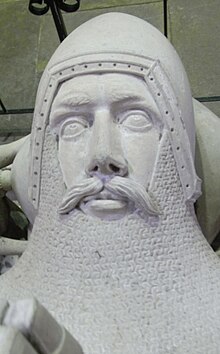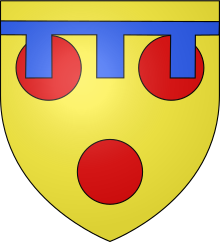Hugh de Courtenay | |
|---|---|
| 2nd/10th Earl of Devon | |
 Effigy (restored) of Hugh de Courtenay, 2nd/10th Earl of Devon, south transept, Exeter Cathedral | |
| Born | 12 July 1303 |
| Died | 2 May 1377 (aged 73) |
| Noble family | Courtenay |
| Spouse(s) | Margaret de Bohun |
| Issue | Sir Hugh Courtenay, KG Thomas Courtenay Sir Edward Courtenay Robert Courtenay William Courtenay, Archbishop of Canterbury Sir Philip Courtenay Sir Peter Courtenay, KG Humphrey Courtenay Margaret Courtenay (the elder) Elizabeth Courtenay Katherine Courtenay Anne Courtenay Joan Courtenay Margaret Courtenay (the younger) ______ Courtenay (7th daughter) ______ Courtenay (8th daughter) ______ Courtenay (9th daughter) |
| Father | Hugh de Courtenay, 1st/9th Earl of Devon |
| Mother | Agnes de Saint John |


Sir Hugh de Courtenay, 2nd/10th Earl of Devon[1] (12 July 1303 – 2 May 1377),[2] 2nd Baron Courtenay, feudal baron of Okehampton[3] and feudal baron of Plympton,[4] played an important role in the Hundred Years War in the service of King Edward III. His chief seats were Tiverton Castle and Okehampton Castle in Devon. The ordinal number given to the early Courtenay Earls of Devon depends on whether the earldom is deemed a new creation by the letters patent granted 22 February 1334/5 or whether it is deemed a restitution of the old dignity of the de Redvers family. Authorities differ in their opinions,[5] and thus alternative ordinal numbers exist, given here.
- ^ Ordinal number 2nd or 10th uncertain, depending on whether Courtenay earldom deemed a continuation of Redvers earldom or a new earldom
- ^ Richardson I 2011, p. 540.
- ^ Sanders, I.J. English Baronies: A Study of their Origin and Descent 1086-1327, Oxford, 1960, p.70
- ^ Sanders, p.138
- ^ Watson, in Cokayne, The Complete Peerage, new edition, IV, p.324 & footnote (c): "This would appear more like a restitution of the old dignity than the creation of a new earldom"; Debrett's Peerage, however, gives the ordinal numbers as if a new earldom had been created. (Montague-Smith, P.W. (ed.), Debrett's Peerage, Baronetage, Knightage and Companionage, Kelly's Directories Ltd, Kingston-upon-Thames, 1968, p.353)